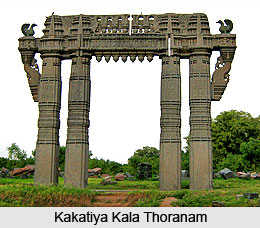 History of Warangal includes the rise and fall of glorious Kakatiya rulers. Warangal, now under Warangal District of Telangana was the capital of Kakatiya kingdom in the early medieval times. It was ruled by the Kakatiya dynasty from the 12th to the 14th centuries with much pomp and power.
History of Warangal includes the rise and fall of glorious Kakatiya rulers. Warangal, now under Warangal District of Telangana was the capital of Kakatiya kingdom in the early medieval times. It was ruled by the Kakatiya dynasty from the 12th to the 14th centuries with much pomp and power.
The Kakatiyas left many monuments, including an impressive fortress, four massive stone gateways, the Swayambhu temple dedicated to Lord Shiva or Mahadeva, and the Ramappa temple situated near Ramappa Lake. The historical monuments of Warangal with excellent architectural styles have been attracting a wide variety of people from various parts of the world.
Warangal is an important cultural centre like, "Rajamahendravaram", which gave birth to `Adikavi Nannaya`, it could claim equal status as the great poet Pothana the author of "Srimad Bhagavatam", one of the finest creations in Classical Telugu literature, born in this place.
Warangal was the seat of the Kakatiya rulers till its decline. It was the place of rich cultural heritage of South India. The cultural and administrative distinction of the Kakatiyas was mentioned by the famous Italian traveller Marco Polo. After the defeat of Pratapa Rudra, the Musunuri Nayaks united seventy two Nayak chieftains and captured Warangal from Delhi sultanate and ruled for fifty years with great pomp and power.
The Mughal emperor Aurangzeb conquered Golconda in 1687, and it remained part of the Mughal Empire until the southern provinces of the empire split away to become the state of Hyderabad under Nizams in 1724, which included the Telangana region and some parts of Maharashtra and Karnataka. During the regime of British East India Company and the British Government in India, Warangal was ruled by the feudal lords of Nizams.
After the Independence of India, Hyderabad was annexed to India in the year 1948, and became an Indian state. In the year 1956, Hyderabad was partitioned as part of the States Reorganization Act, and Telangana, the Telugu-speaking region of Hyderabad state, which includes Warangal that became part of Andhra Pradesh. In the year 2014, Warangal is included in Warangal District under the statehood of Telangana, a newly formed state under the government rule of Union of India, with capital Hyderabad for 10 years.



















